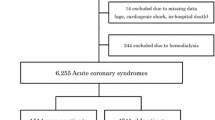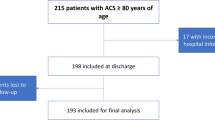Abstract
Introduction
Acute coronary syndromes (ACS) in young patients are uncommon and their influence on morbidity and mortality in this population is still debated.
Aim
We investigated clinical and angiographic characteristics, risk factors and outcome in young patients diagnosed with ACS, compared with those of older patients, evaluating survival free from death and/or nonfatal myocardial infarction (MI) and/or coronary revascularization (primary endpoint), and then with respect to each component of the primary endpoint.
Methods
We retrospectively analyzed 1696 patients diagnosed with ACS between 2007 and 2013. 116 were aged ≤45 years (young adults), 1116 were >45 and <75 years (older adults) and 464 were ≥75 years.
Results
Young adults were mostly male, with a prevalent diagnosis of STEMI, had less frequently typical cardiovascular risk factors and lower prevalence of extensive coronary artery disease. Over a median 3 years follow up, survival free from composite endpoint was better in young than in older adult patients (11.2 vs. 24.2%; p = 0.001), mainly due to a lower rate of death while the occurrence of non fatal MI and of coronary revascularization was similar (7.8 vs. 8.7%, p = 0.86; 8.7 vs. 12.9%, p = 0.23 respectively). Diabetes was the strongest independent risk factor of worse prognosis in the young cohort (OR 3.47; 95% CI 1.01–11.9; p = 0.04).
Conclusions
Young adults showed peculiar clinical features and lower mortality compared with older adults. Morbidity was not different between the two populations, with diabetes independently associated with a worse prognosis.



Similar content being viewed by others
References
Hoit BD, Gilpin EA, Henning H, Maisel AA, Dittrich H, Carlisle J, et al. Myocardial infarction in young patients: an analysis by age subsets. Circulation. 1986;74(4):712–21.
Zimmerman FH, Cameron A, Fisher LD, Ng G. Myocardial infarction in young adults: angiographic characterization, risk factors and prognosis (Coronary Artery Surgery Study Registry). J Am Coll Cardiol. 1995;26(3):654–61.
Choudhury L, Marsh JD. Myocardial infarction in young patients. Am J Med. 1999;107(3):254–61.
Doughty M, Mehta R, Bruckman D, Das S, Karavite D, Tsai T, et al. Acute myocardial infarction in the young—the University of Michigan experience. Am Heart J. 2002;143(1):56–62.
Rathod KS, Jones DA, Gallagher S, Rathod VS, Weerackody R, Jain AK, et al. Atypical risk factor profile and excellent long-term outcomes of young patients treated with primary percutaneous coronary intervention for ST-elevation myocardial infarction. Eur Heart J Acute Cardiovasc Care. 2016;5(1):23–32.
Bajaj S, Shamoon F, Gupta N, Parikh R, Parikh N, Debari VA, et al. Acute ST-segment elevation myocardial infarction in young adults: who is at risk? Coron Artery Dis. 2011;22(4):238–44.
Wolfe MW, Vacek JL. Myocardial infarction in the young. Angiographic features and risk factor analysis of patients with myocardial infarction at or before the age of 35 years. Chest. 1988;94(5):926–30.
Schoenenberger AW, Radovanovic D, Stauffer JC, Windecker S, Urban P, Niedermaier G, et al. Acute coronary syndromes in young patients: presentation, treatment and outcome. Int J Cardiol. 2011;148(3):300–4.
Puricel S, Lehner C, Oberhänsli M, Rutz T, Togni M, Stadelmann M, et al. Acute coronary syndrome in patients younger than 30 years–aetiologies, baseline characteristics and long-term clinical outcome. Swiss Med Wkly. 2013;143:w13816. doi:10.4414/smw.2013.13816. Accessed 6 May 2016.
Chen L, Chester M, Kaski JC. Clinical factors and angiographic features associated with premature coronary artery disease. Chest. 1995;108:364–9.
Esteban MR, Montero SM, Sánchez JJ, Hernández HP, Pérez JJ, Afonso JH, et al. Acute coronary syndrome in the young: clinical characteristics, risk factors and prognosis. Open Cardiovasc Med J. 2014;25(8):61–7.
Kanitz MG, Giovannucci SJ, Jones JS, Mott M. Myocardial infarction in young adults: risk factors and clinical features. J Emerg Med. 1996;14(2):139–145.
Cole JH, Miller JI 3rd, Sperling LS, Weintraub WS. Long-term follow-up of coronary artery disease presenting in young adults. J Am Coll Cardiol. 2003;41(4):521–8.
Ergelen M, Uyarel H, Gorgulu S, Norgaz T, Ayhan E, Akkaya E, et al. Comparison of outcomes in young versus nonyoung patients with ST elevation myocardial infarction treated by primary angioplasty. Coron Artery Dis. 2010;21(2):72–7.
Maroszyńska-Dmoch EM, Wożakowska-Kapłon B. Clinical and angiographic characteristics of coronary artery disease in young adults: a single centre study. Kardiol Pol. 2016;74(4):314–21.
Thygesen K, Alpert JS, Jaffe AS, Simoons ML, Chaitman BR, White HD, et al. Third universal definition of myocardial infarction. Eur Heart J. 2012;33(20):2551–67.
Goff DC Jr, Lloyd-Jones DM, Bennett G, Coady S, D’Agostino RB Sr, Gibbons R, et al. 2013 ACC/AHA guideline on the assessment of cardiovascular risk: a report of the American College of Cardiology/American Heart Association Task Force on Practice Guidelines. J Am Coll Cardiol. 2014;63:2935–59.
Solomon SD, Anavekar N, Skali H, McMurray JJ, Swedberg K, Yusuf S, et al. Influence of ejection fraction on cardiovascular outcomes in a broad spectrum of heart failure patients. Circulation. 2005;112(24):3738–44.
Subherwal S, Bach RG, Chen AY, Gage BF, Rao SV, Newby LK, et al. Baseline risk of major bleeding in non-ST-segment-elevation myocardial infarction: the CRUSADE (Can Rapid risk stratification of Unstable angina patients Suppress ADverse outcomes with Early implementation of the ACC/AHA Guidelines) Bleeding Score. Circulation. 2009;119(14):1873–82.
Fox KA, Fitzgerald G, Puymirat E, Huang W, Carruthers K, Simon T, et al. Should patients with acute coronary disease be stratified for management according to their risk? Derivation, external validation and outcomes using the updated GRACE risk score. BMJ Open. 2014;4(2):e004425. doi:10.1136/bmjopen-2013-004425.
Mozaffarian D, Benjamin EJ, Go AS, Arnett DK, Blaha MJ, Cushman M, On behalf of the American Heart Association Statistics Committee and Stroke Statistics Subcommittee, et al. Heart disease and stroke statistics—2015 update: a report from the American Heart Association. Circulation. 2015;131(4):e29–322. doi:10.1161/CIR.0000000000000152. Accessed 6 May 2016 (Epub 2014 Dec 17).
Phillips K, Luk A, Soor GS, Abraham JR, Leong S, Butany J. Cocaine cardiotoxicity: a review of the pathophysiology, pathology, and treatment options. Am J Cardiovasc Drugs. 2009;9(3):177–96.
Panayiotides IM. What is the association of cannabis consumption and cardiovascular complications? Subst Abuse. 2015;2(9):1–3.
Colkesen AY, Acil T, Demircan S, Sezgin AT, Muderrisoglu H. Coronary lesion type, location, and characteristics of acute ST elevation myocardial infarction in young adults under 35 years of age. Coron Artery Dis. 2008;19(5):345–7.
Roshanzamir S, Showkathali R. Takotsubo cardiomyopathy a short review. Curr Cardiol Rev. 2013;9(3):191–6.
Gallagher S, Jones DA, Anand V, Mohiddin S. Diagnosis and management of patients with acute cardiac symptoms, troponin elevation and culprit-free angiograms. Heart. 2012;98(13):974–81.
Monney PA, Sekhri N, Burchell T, Knight C, Davies C, Deaner A, et al. Acute myocarditis presenting as acute coronary syndrome: role of early cardiac magnetic resonance in its diagnosis. Heart. 2011;97(16):1312–8.
Author information
Authors and Affiliations
Corresponding author
Ethics declarations
Conflict of interest
Authors have no conflicts of interest to declare.
Ethical approval
All procedures performed involving human participants were in accordance with the ethical standards of the institutional and/or national research committee and with the 1964 Helsinki declaration and its later amendments or comparable ethical standards.
Informed consent
Informed consent was obtained from all individual participants included in the study.
Rights and permissions
About this article
Cite this article
Tini, G., Proietti, G., Casenghi, M. et al. Long-Term Outcome of Acute Coronary Syndromes in Young Patients. High Blood Press Cardiovasc Prev 24, 77–84 (2017). https://doi.org/10.1007/s40292-017-0183-6
Received:
Accepted:
Published:
Issue Date:
DOI: https://doi.org/10.1007/s40292-017-0183-6




